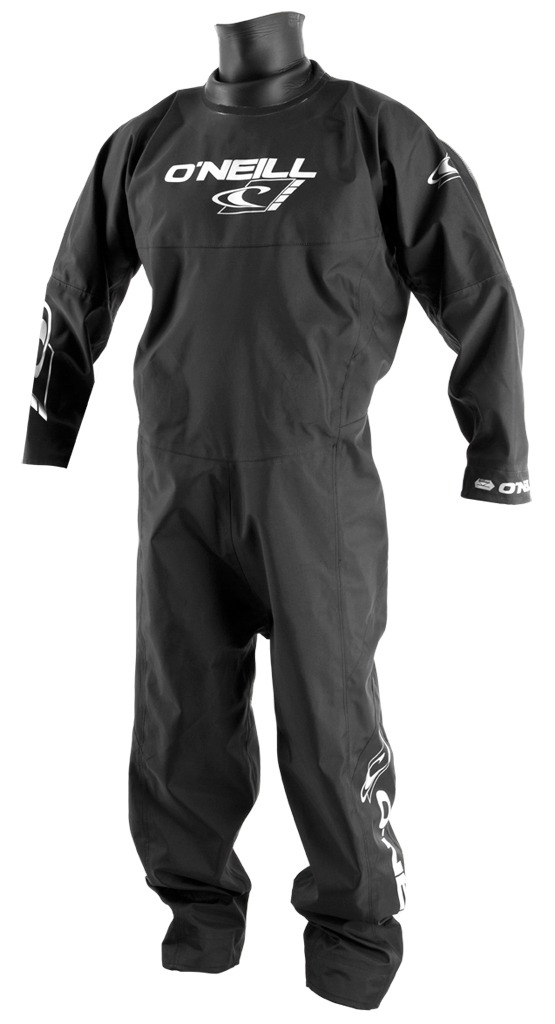What Is a Drysuit & How Does It Work?
James Warnet May 9th, 2019 Posted In: Articles
What is a Drysuit and How Does it Work?
Any water less than 98 degrees will cool down the human body. Depending on how cold the water depends on how fast the body cools down. And since the human body loses heat 25 times faster in water than it does in air, it won’t take long to get cold in chilly water. Unfortunately, most of our favorite watersports don’t happen in water that is 98 degrees!
So how do we get to enjoy ourselves without freezing? Drysuits!
How Does a Drysuit Work?
First, what is a drysuit? Well, to put it simply, drysuits are a full-body suit that is designed to remain entirely water-tight; keeping you dry while you are out enjoying your favorite watersports. These suits are typically made from synthetic rubber or neoprene, with a tough exterior shell. Flexible rubber seals around the wearer’s neck and wrists keep the water out, and the main suit zipper (also waterproof) means the wearer can put on the suit easily.
Now, because the drysuit will keep out any water, the wearer can wear whatever clothes they want underneath! Typically, you will want to wear an insulating layer under your drysuit, such as fleece or cotton sweats, since the suit itself is not insulated. The drysuit may keep you dry, but without additional insulation, you may still get cold.
Drysuits work by enclosing the wearer in a layer that is 100% watertight. The rubber seals, or gaskets, around the wearer’s neck and wrists are typically two parts: an inner and outer seal. Each part is comprised of a flexible rubber membrane that fits snugly around the wearer’s skin; preventing water from entering the suit. Because the membranes flex easily, the wearer can move about at will and the suit will move with them.
For your feet, drysuits will either have ‘socks’ attached to them, much like footie pajamas, or the same type of seals found on the neck and wrists. For suits with socks, they are made of a similar material as the rest of the suit and keep the feet completely dry.
After putting on the drysuit, the wearer will put a specially-designed boot on over the ‘socks’ so that sharp rocks won’t puncture the suit. Suits without socks also need foot protection of some kind.
How Does a Drysuit Differ from a Wetsuit?
Wetsuits work in a different way to keep the wearer warm. Instead of keeping the water out, like a drysuit, wetsuits allow the water in. After the suit is wet, a thin layer of water will be inside the suit between the suit and the wearer’s skin. The body will heat that water and slow down the amount of heat the wearer loses. Instead of the skin being in, say, 50-degree water, the thin water layer may heat up to, say, 90 degrees. Wetsuits also have different thicknesses, adding insulation for colder water.
The downside to wetsuits is that small body movements can let some of this heated water escape and fresh cold water to replace it. This can lead to a constant shock of cold water hitting the skin. To minimize this, modern wetsuit technology, such as special seams, seals and fleece, make some wetsuits ‘semi-dry’.
Also, wetsuits fit tightly to the wearer. For some people, it can feel like they are wearing a just-too-tight second skin, and suits that aren’t sized perfectly will lead to a lose of flexibility and movement. Feel free to check out our post on how a wetsuit works!
What Activities Can I Use a Drysuit For?
Drysuits work for any activity that involves being in the water! While drysuits were primarily designed to protect SCUBA divers in cold water, drysuits have been adapted to many other activities. You can find drysuits specifically designed for kayakers, wake-boarders, surfers, waterskiers, and paddleboarders.
Desirable Drysuit Features
So, what are the features of a good drysuit? Well, that depends on the activity you want a drysuit for. Some drysuits are created with a ‘baggier’ design, allowing for less constricted movement and more insulating layers. These drysuits are typically suited for colder water where insulation is a must.
If your watersport activity is occurring in waters that are not quite cold but certainly not 98 degrees, a more tight-fitting suit might be in order. Drysuits in this category will keep the wearer dry, but the tighter fitting design sacrifices some insulation space for a range of motion.
Enjoy Your Activities!
Whether you choose to wear a wetsuit or a drysuit, having good exposure protection will mean you can enjoy your activity safer and for longer. After all, who wants to have to get out of the water too early?



What is the best option dry or wet suit for survival at sea after say a ship capsizes around Bahamas or Domenican Republic area? Or say you need to make a 50 to hundred mile swim to shore.
Hi John! Wetsuit Wearhouse cannot recommend any product for your survival or your safety in an emergency. You can browse our selection of open water swimming wetsuits that we stock here for ocean swimming, or I recommend you check out Mustang Survival here who can perhaps offer you a more specialized recommendation for your wetsuit needs. Hope this helps!